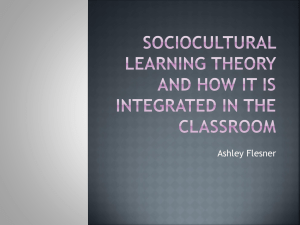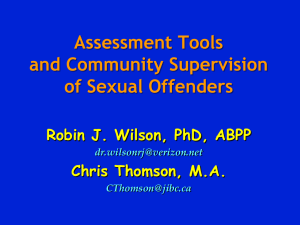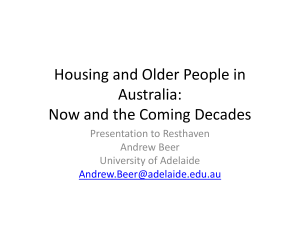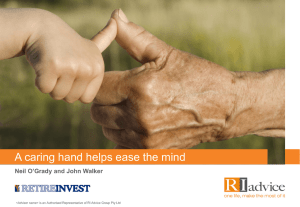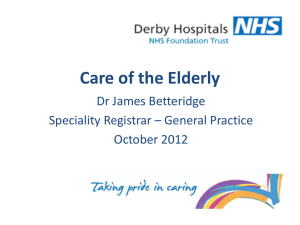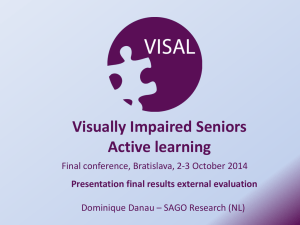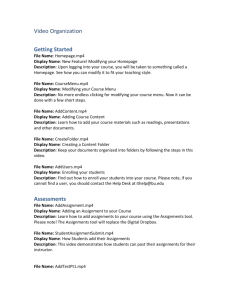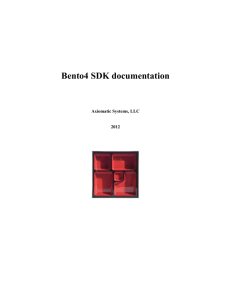HSC Option 1: The Health of Young People
advertisement
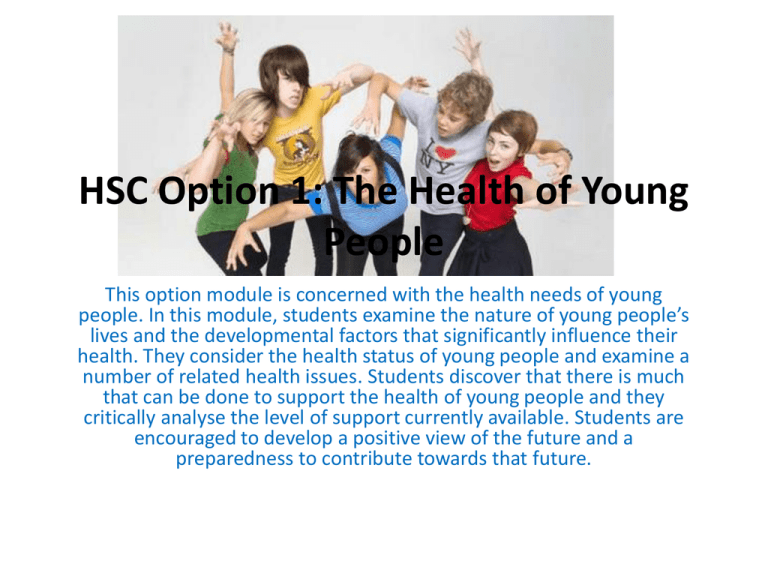
HSC Option 1: The Health of Young People This option module is concerned with the health needs of young people. In this module, students examine the nature of young people’s lives and the developmental factors that significantly influence their health. They consider the health status of young people and examine a number of related health issues. Students discover that there is much that can be done to support the health of young people and they critically analyse the level of support currently available. Students are encouraged to develop a positive view of the future and a preparedness to contribute towards that future. AIHW RESEARCH A Picture of Australia’s Children 2009 http://www.aihw.gov.au/publications/phe/phe-112-10704/phe-11210704-c00.pdf • Young People's health and wellbeing http://www.aihw.gov.au/publications/index.cfm/title/10451 Youth is a period of rapid emotional, physical and intellectual change, where young people progress from being dependent children to independent adults. Young people who are unable to make this transition smoothly can face significant difficulties in both the short and long term. All levels of governments are interested in positively influencing the environment of young people by providing support in areas such as health, education, welfare, work and safety. Prevention and early intervention are the key themes for current policies. Data which support a better understanding of the needs of young people and their families are therefore of critical importance. 3 questions????? • What is good health for young people? • To what extent do Australia’s young people enjoy good health? • What skills and actions enable young people to attain better health? What is good health for young people? the nature of young people’s lives •how the developmental stage can vary in motivations, values, sociocultural background •the influence of family/peers •the influence of prevailing youth cultures •the influence of global events and trends •the influence of technology How would you describe a young persons life? - how the developmental stage can vary in motivations, values, sociocultural background Rate of Physical development mature at different rates, growth spurts, physical maturity often comes before emotional maturity. Level of motivation motivation is result of mental attitudes and emotional maturity, labelled lazy, leisure conflict with family expectations Socioeconomic background uneven distribution of wealth Sociocultural background. Multicultural variety – customs, beliefs, tradtions. - the influence of family/peers The family can have a positive or negative influence on the development of the adolescent – rules, expectations, care, communication . Your peers too can influence attitudes and behaviours. As for conflict between the two!!!! How does your family / peer group influence you in the way you live your life and the adult you are becoming? - the influence of prevailing youth cultures Identify youth cultures that you know of: goth, skateboarder, surfie, emo, punks, ravers, rockers, nerds, gamers. Originally subcultures were identified with transport (bikes etc) then with music (grunge) but then the commercial world identified the profit potential of cashedup youth and the symbols that represent a certain youth culture.(Nike, Billabong) Young people need to feel that they belong and strive for the required look – to confirm identity and maintain self esteem and self confidence. Identifying with a certain youth culture is not necessarily negative. They can provide support and security until the confidence of adulthood is gained. ..\Documents\SENIORS\HEALTH OF YOUNG PEOPLE\1_3_Psychology_experiment_on_adolescent_confor mity_[www.keepvid.com].mp4 the influence of global events and trends Identify the global events that have happened in the last few months and how quick did you find out about them. Bad news travels fast and this can lead young people to have a pessimistic view of the future and it needs to be balanced with the idea that good news is rarely reported. Global issues though have prompted young people into action – streamwatch, forums, protests. International competitions can influence young people to participate in various sports but also lead to negative attitudes towards officials and the rise of violence in schools. the influence of technology Identify all of the ways you can use technology to communicate Technology has influenced job creation, access to information, music, games, videos regardless of classification, and language. It has led to a generation driven to stay in touch while developing the ability to multitask. expensive contracts, pressure on parents to supply mobiles to young children, theft of phones, uncensored material desensitising young, copy cat behaviour, medical conditions (RSI, obesity), cyberbullying, identity theft, gate crashing. • epidemiology of the health of young people Epidemiology is the study of disease in groups and populations in general over a period of time. lower rates of mortality higher level of morbidity mental disorders, injury and poisioning . the effects of the determinants of health on young people - individual factors - sociocultural factors ..\Documents\SENI ORS\HEALTH OF YOUNG PEOPLE\The_Media s_influence_on_Bod y_Image_[www.kee pvid.com].mp4 socioeconomic factors • • • • • • • • • • Young people of low SES... practice unhealthy behaviours develop poor eating habits live in large families unable to defer gratification use physical violence to solve problems higher unplanned pregnancies anti-work ethic lack up to date health knowledge move house more frequently. • Unemployed • part time or casual employment • lower rates of pay • lower standards of living Conditions that contribute to ill health. • • • • drive less safe cars shared accommodation resort to crime do not have health insurance. • Employment high rates of unemployment unpaid overtime dole bludger labels dangerous part time work late hours / fatigue budgeting, resilience. • Education stay on longer (no jobs) closer relationship between education and business health lessons institutions provide safe environments. - environmental factors ..\Documents\SENIORS\CORE 1\Angel_Flight__Heart_Specialist_ _[www.keepvid.com].mp4 Geography – young people living in or coming from rural and remote communities suffer worse health due to reduced employment opportunities, reluctance to wear seatbelts, rural poverty harsher climate exposure to chemicals and a ‘tough’ attitude. Access to health services – long distances separation from family for treatments waiting times need strong health literacy skills. - Use of technology + • more socially connected • develop highly sought after specialised skills which can benefit their quality of life and therefore health • reduce activity leading to obesity • lead to addiction • reduce face to face communication skills • detached from reality • cost • developmental aspects that affect the health of young people - revising roles within relationships clarifying self-identity and self-worth developing self-sufficiency and autonomy establishing education, training and employment pathways - establishing personal support structures - determining behavioural boundaries. - revising roles within relationships • infancy..childhood..adolescence..adulthood..parenthood Equal / submissive / dominant role? Protective / nurturing role? Increasing responsibility / expectations / autonomy / freedom? Role ambiguity? Balance of power? Platonic / sexual / sexual orientation / committed relationships? Pregnancy? Implications? Unwanted pregnancies, bullying, stress from too much responsibility, family conflict. clarifying self-identity and self-worth play description game • Our self identity is how we describe ourselves. • Schools can provide positive experiences which develop a positive sense of self. Perceived failure can have the opposite effect. • Society’s norms, values and beliefs also influence during socialisation process – specific roles, commercialisation of ‘identity’ e.g. clothing labels, problem for low SES. • Implications? Mental health issues, hiding sexual identity, bullying, eating disorders, anxiety. http://www.youtube.com/watch?v=p0hutLWvrEg - developing self-sufficiency and autonomy Analyse the concept of ‘student voice’ in PE (which is part of the Girls In Sport project..\Documents\SENIORS\HEALTH OF YOUNG PEOPLE\1_3_Psychology_experiment_on_adol escent_conformity_[wnhww.keepvid.com].mp 4 establishing education, training and employment pathways • A solid education provides the foundation for reaching personal potential and positive self esteem. • Today’s young have many options – TAFE, School-based apprenticeships, VET. • Part time work can lead to career pathways high self esteem job skills transition options Income Responsibility time management skills. establishing personal support structures • A good support structure is based on mutual respect, trust and shared responsibility offering financial, emotional, physical and mental support. They are able to cope with stress and have someone to turn to. Alternative support (from family) is available from government agencies and in the community, though the family is the best for promoting good health. • What support is available at WHS? determining behavioural boundaries • This is the time to test boundaries and learn acceptable limits. Families that set limits and impose consequences will help. Some families though do not and these adolescents often develop a belief in their own impunity • Laws are developed to protect young people from themselves and others. • Describe laws which apply to young people and not adults. Sexual activity, driving, drinking, use of car restraints, licensed premises, smoking. Why are they in place? • Young people who are unwilling to accept family, school and society’s boundaries and who cannot set their own often engage in negative health behaviours and end up isolated (juvenile justice, school phobia, suspensions) often compelled by peers. • Implications? Injury, disability, dysfunction, stress related disorders. think critically about how young people’s priorities and values relate to their health by considering questions such as: • Is health a priority for young people? • What would young people view as the indicators of good health? To what extent do Australia’s young people enjoy good health? • – – – – – – – the major health issues that impact on young people mental health problems and illnesses alcohol consumption violence road safety sexual health body image other relevant/emerging health issues, eg gambling, cyber-bullying, party crashes, drink spiking http://www.aihw.gov.au/publications/aus/yathaw07/yathaw07.p df Areas in which young Australians are faring well • Life expectancy at birth has improved over the last 20 years: a gain of 5.6 years for males and 4 years for females. A boy born in 2002–2004 would be expected to live to 78.1 years, on average, while a girl would be expected to live to 83.0 years, on average. • Death rates among young people aged 12–24 years halved between 1980 and 2004, largely due to decreases in deaths due to injury (including poisoning). Suicide and transport accident deaths declined by 40% and 35% respectively between 1995 and 2004 and deaths due to drug dependence disorder decreased from 142 deaths in 1997 to 3 deaths in 2004. • Over 90% of young people rate their health as excellent, very good or good. • Young people are less likely to have a ‘severe disability’ than people in other age groups (2% of young people). • Asthma prevalence, although still higher than the general population, has declined from 16% to 13% between 2001 and 2004−05 for young people and hospital separation rates for asthma have more than halved between 1996–97 and 2004−05. Between 1993–97 and 1998–2002, the rate of melanoma incidence decreased by 23% (from 7.6 to 5.9 per 100,000 young people) for males and by 14% (from 9.1 to 7.8 per 100,000 young people) for females. • The incidence of most vaccine-preventable communicable diseases is low. There has been a large decline in the notification rates for measles and rubella over the last decade and for meningococcal disease since 2003. The notification rates for meningococcal diseases, rubella and mumps were less than 3 per 100,000 each in 2005. Large declines have also been observed in notification rates for hepatitis A and B between 1995 and 2005 (a rate of 2.1 and 1.4 per 100,000 respectively in 2005). There has been an overall fall in the HIV notification rate since 1995, although a slight upward trend has been observed in recent years (a rate of 2.5 per 100,000 in 2005). • Increasing proportions of young people are free from clinical tooth decay. Sixty per cent of those aged 12 years and 40% of those aged 15 years were decay free in 2001, an almost 1.7 fold increase since 1990. • Young people aged 15–24 years accounted for 8% of the total disease and injury burden in 2003, with 71 disability-adjusted life years (DALYs) per 100,000 young people. This was half the rate for all Australians. • Of young people living in families, most (80%) were living in couple-parent families in 2003. Young people in couple parent families were more likely than young people from lone-parent families to have an ‘employed’ parent or one that had completed secondary school. • The vast majority (90%) of young people were living in households that were not considered to be overcrowded in 2001. • Most Year 7 students met the national benchmarks for reading, writing and numeracy (91%, 94% and 82%) in 2004. • The apparent retention rate to Year 12 has increased substantially from 49% in 1986 to 75% in 2006 and the proportion of those aged 15–24 years with post-school qualifications rose from 23% to 26% between 1996 and 2006. • The majority of young people (85% of those aged 15–19 years and 76% of those aged 20–24 years) were participating full time in education and/or work in 2006. • analyse TWO of the major health issues listed by examining: – the nature and extent of the major health issue – the risk factors and protective factors – the sociocultural, socioeconomic and environmental determinants – young people most at risk Significant areas of concern for young people • • • • • • • • • • • • • Mental disorders accounted for almost 50% of the total disease burden Injury (including poisoning) continues to be the leading cause of death for young people, accounting for two-thirds of all deaths of young people Crohn’s disease, diabetes increasing 25% of young people in 2004–05 were overweight or obese, increasing. less than half of young people (46% of males and 30% of females) were meeting recommended physical activity guidelines Less than half (47%) meeting the daily vegetable consumption guidelines Melanoma remains the type of cancer with the highest incidence rate among young people. Almost one-third (31%) of young people drank alcohol in amounts that put them at risk or high risk of alcohol-related harm in the short term, and 11% at risk of long-term harm. Around 17% of young people were current smokers in 2004. Young mothers smoke more. The unemployment rates for 15–19 and 20–24 year olds were 12.5% and 6.3% Around 13% of young people were exposed to tobacco smoke The proportion of young people on care and protection orders and in out-of-home care continued to increase. Young adults (those aged 18–24 years) accounted for 20% of the total prison population Know them all but know 2 in depth. • analyse IMPLICATIONS TWO of the major health issues listed by examining: – the nature and extent of the major health issue – the risk factors and protective factors – the sociocultural, socioeconomic and environmental determinants – young people most at risk • the major health issues that impact on young people – mental health problems and illnesses What causes stress in your life? What about 6 weeks time??? What are your ‘symptoms’? Stress!!! General Nature Depression Experience of loss Schizophrenia Group of disorders – hallucinations, delusions, disordered thought http://www.youtube.com /watch?v=yBHehebPvl8& feature=relateds Self harm Suicide ..\Documents\SENIORS\HEA LTH OF YOUNG PEOPLE\Self_Harm_[www.ke epvid.com].mp4 ...\Documents\SENIORS\HEALTH OF YOUNG PEOPLE\Teen_CyberBulled_to_Death__[www.keepvid.com].mp4 RISK FACTORS FOR MENTAL HEALTH From reading your notes from the ‘snapshot’ suggest what the risk factors are. Are you right? • • • • • • • Unemployment Low level of education Isolation Sexuality issues Low self-esteem Social alienation Access to firearms – rural males • Incarceration • • • • • • • Family breakdown Substance abuse Sexual abuse Low SES ATSI Gender Family history of mental illness MENTAL HEALTH DETERMINANTS SOCIOCULTURAL Family disharmony Changing family structure Peer expectations – or + Media stereotypes Conflict: culture & society Racism, homophobia SOCIOECONOMIC ENVIRONMENTAL Unemployment Low level of education Slow economic growth Low SES Workplace contracts Economic globalisation PT and Casual’ National literacy and numeracy benchmarks Geographic location – city vs rural Remoteness Access to health services Access to technology Supply of nutritious food Pollution Overcrowding Inadequate housing Poor infrastructure. PROTECTIVE FACTORS FOR MENTAL HEALTH From reading your notes from the ‘snapshot’ suggest what the risk factors are. Are you right? • Strong personal support • network • Personal skills – • assertiveness, resilience • • Laws • Access to health services • • Education of youth • workers and professionals • • Societal and cultural norms protecting young Participation in decision making Adequate nutrition Positive school environment Economic security Completion of Yr 12 Youth allowance • major health issues cont’d – body image • major health issues cont’d - alcohol consumption major health issues cont’d - violence • major health issues cont’d - road safety • major health issues cont’d – sexual health • major health issues cont’d – other relevant/emerging health issues, eg gambling, cyber-bullying, party crashes, drink spiking What skills and actions enable young people to attain better health? • skills in attaining better health – building self concept – developing connectedness and support networks – developing resilience and coping skills – developing health literacy skills – developing communication skills – accessing health services – becoming involved in community service •connectedness with community • skills in attaining better health cont’d - building self concept Self concept involves 3 areas: self worth, healthy body image and self efficacy. How could a young person’ feelings of self worth be developed? Positive experiences, leadership training, wilderness type challenges, volunteer work, praise, positive behaviour strategies, less emphasis on winning. How could a healthy body image be developed? Media standards, role models, workshops, A person needs confidence that they are capable of carrying out a task. How could such confidence or self efficacy be developed? Skill development, workshops, cooperative / team activities, ropes courses, camps, challenges, a role in decision making eg via forums, SRC, youth councils • skills in attaining better health cont’d -developing connectedness and support networks o connectedness with community o Positive Interpersonal relationships o Supportive networks..\Documents\SENIORS\HEALTH OF YOUNG PEOPLE\canteen.mp4. ..\Documents\SENIORS\HEALTH OF YOUNG PEOPLE\Hannah_s_Story_[www.keepvid.com].mp4 Why might a young person not seek or accept support? Fear of labelling / repercussions, macho image, stereotyping, language/cultural barriers, family issues, poor health literacy, parental expectations, isolation, ‘handle it’ attitude e.g. Hanna Modra How could these barriers be overcome? Cultural exchange programs, media role models, balanced representation of young people, health professional outreach programs, support family, health promoting curricula, sensitive health and counselling services., parent education, lobbying for infrastructure What do young people need? Counselling, advice, money, accommodation, legal advice, employment help, medical, mentoring. • skills in attaining better health cont’d developing resilience and coping skills • skills in attaining better health – developing health literacy skills • • • • • • Address? Empower? Determinant? Facilitate? Intersectoral collaboration? Proprioceptive neuromuscular facilitation??? • skills in attaining better health cont’d – developing communication skills • skills in attaining better health cont’d – accessing health services • skills in attaining better health cont’d – becoming involved in community service • critically reflect on their own personal health and health behaviours including both positive and negative influences and indicate future courses of action for better health • actions targeting health issues relevant to young people – legislation and public policy • actions targeting health issues relevant to young people - health promotion initiatives. • evaluate a range of strategies that have been implemented by government and nongovernment agencies that target TWO major health issues impacting on young people – social action
